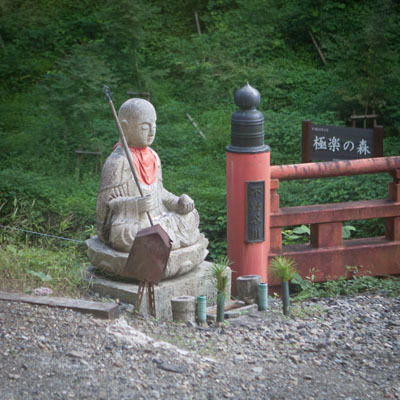People here in Japan were curious as to why I would want to go Koyasan. It’s out of the way and nothing but temples. Plus, it’s a little bit of a pain to get there when you have to tote a suitcase. But, I decided to go becasue I thought it would give me a better glimpse into the traditional Buddhist element of Japan, clearer than just going to the main temples all the toursits go to.
Here’s some background on Koyasan from an excellent website on Japan and Japan travel called Japan Guide:
“Mount Koya (Koyasan) is the center of Shingon Buddhism, an important Buddhist sect which was introduced to Japan in 805 by Kobo Daishi (also known as Kukai), one of Japan’s most significant religious figures. A small, secluded temple town has developed around the sect’s headquarters that Kobo Daishi built on Koyasan’s wooded mountaintop. It is also the site of Kobo Daishi’s mausoleum and the start and end point of the Shikoku 88 Temple Pilgrimage.
Kobo Daishi began construction on the original Garan temple complex in 826 after wandering the country for years in search of a suitable place to center his religion. Since then over one hundredtemples have sprung up along the streets of Koyasan. The most important among them are Kongobuji, the head temple of Shingon Buddhism, and Okunoin, the site of Kobo Daishi’s mausoleum.”
So I made a reservation online to stay the night at a temple named Shojoshin-in, right next to the entrance of the famous cemetery, Okunoin. What an amazing experience! I arrived a just in time to check in as my journey there was a contiuous chain of just in time events, going from train to train to train to cable car to bus.
The train ride from Namba station in Osaka was spectacular. As the train ascended into the mountains, you felt like you were leaving one world and heading into a place that was quite far removed and remote. It turned out I wasn’t the only person on the train like I had thought, there were about 10 other people in the other three cars. After the train, I had to catch a cable car to the top of the mountain and for that, I was the only passenger. I missed the cablecar I was supposed to take since I had to make a short bathrrom stop. It threw off my trip timing and it meant that I would have to hurry even faster once I got to the top.
I got to the top and caught my bus. The fun of that was that the driver spoke no English and you had to push a button when you wanted the bus to stop. It was hard to hear the station announcements. Luckily, my stop was the stop everyone was waiting for so it ended up being no problem. Shojoshin-in was just down the street about 25 yards but the main gate had been closed and it took me a minute to figure out how to get in. I found a gardener who called someone to help me.






